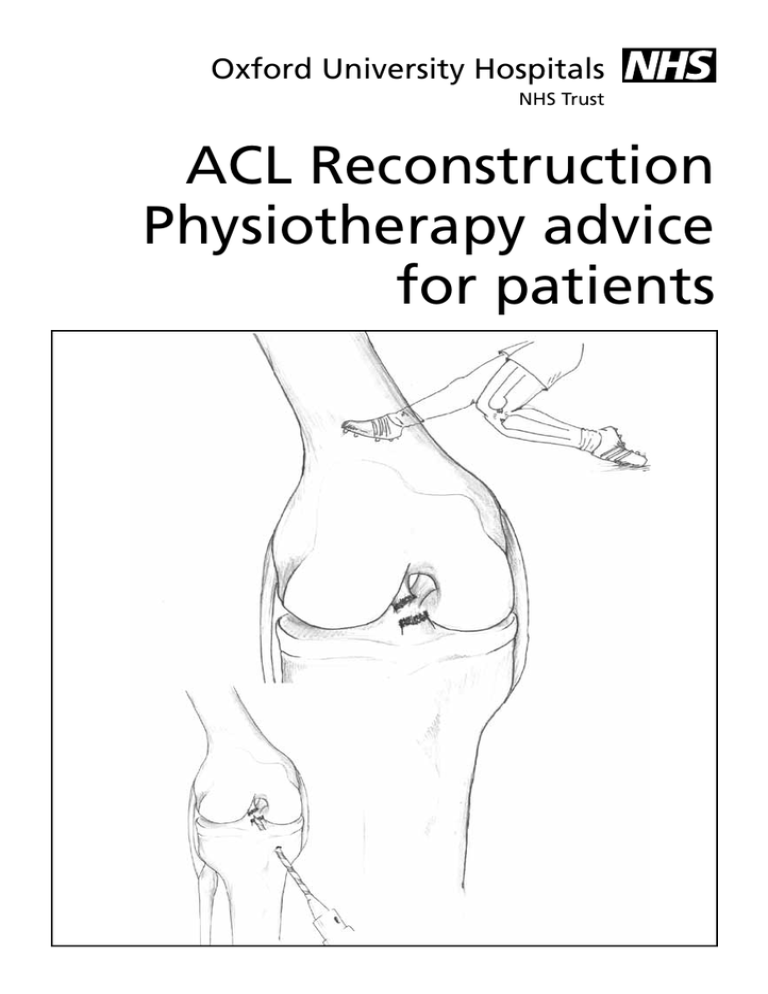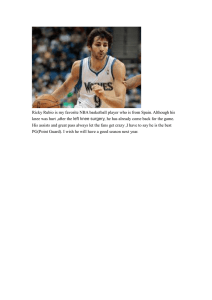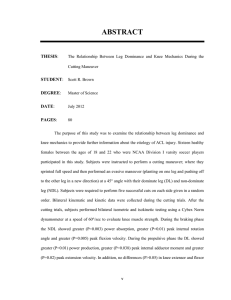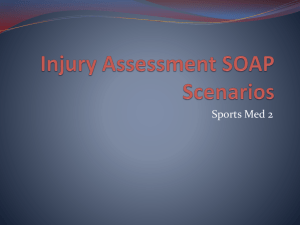ACL Reconstruction Physiotherapy advice for patients
advertisement

Oxford University Hospitals NHS Trust ACL Reconstruction Physiotherapy advice for patients Introduction This booklet is designed to provide you with advice and guidance on your rehabilitation after reconstruction of your anterior cruciate ligament (ACL). It contains detailed exercises appropriate for the different phases of rehabilitation. The exercises will help to strengthen the muscles around the knee and help you to regain full range of movement. Time frames mentioned in this booklet are based on average guidelines but everyone will progress at different rates. Your rehabilitation will be monitored and guided by a Chartered Physiotherapist. General Advice • The graft is at its weakest between 6-12 weeks after your operation. Extra care should be taken during this period when carrying out activities. • You should avoid twisting or kneeling for the first 4-6 months after your operation. Any concerns about any aspects of your rehabilitation should be discussed with your Physiotherapist. Anatomy The knee compromises the joint between the femur (thigh bone) and the tibia (shin bone), and the joint between the patella (knee cap) and the front of the femur. Ligaments around the knee help to stabilize the joint. These include the collateral ligaments either side of the knee and the cruciate Fibula ligaments within the joint. Page 2 Femur (thigh bone) ACL Tibia (shin bone) The anterior cruciate ligament (ACL) stops the tibia shearing forwards. It runs back and upwards from its insertion on the tibia to its origin on the femur. The most important groups of muscles supporting the knee are the quadriceps muscle on the front of the thigh, and the hamstrings which lie at the back of the thigh. The calf muscle (gastrocnemius) provides additional support. Causes of Injury An ACL injury occurs when the ligament is torn or stretched beyond normal range. The cause of an ACL injury may be contact or non-contact. Non contact: • A sudden stop combined with a direction change while running, pivoting or landing from a jump. • Extreme hyperextension (excessive straightening) or hyperflexion (excessive bending) of the knee. Contact: • A direct blow to the outside of the knee or lower leg. Page 3 Surgery The two most common methods of reconstruction are patella tendon grafts and hamstring grafts. (a) The ACL reconstruction with a bone-patellar-tendon-bone autograft The middle third of the patellar tendon, complete with its bony attachment at either end, is removed from the ACL-deficient knee. This strip of patellar tendon is then surgically fitted into the appropriate positions on the femur and tibia to mimic a natural ACL. Section of patella and tendon removed Passage drilled Patella tendon inserted Page 4 (b) ACL reconstruction with a semitendinosis and/or gracilistendon autograft In this procedure the tendons from the semitendinosis and/or gracilis muscles (from the hamstring group in the posterior upper portion of the leg) are cut, stitched together and repositioned within the knee as a substitute for the lost ACL. Hamstring graft prepared Passage drilled Hamstring graft inserted Page 5 After the Operation - “R.I.C.E.” Rest: When resting your leg make sure your knee is straight. DO NOT rest the back of your knee over a pillow. Ice: To reduce swelling and aid pain relief apply ice, contained in a pillow case, around your knee for periods of 15-20 minutes. Compression: If your knee is swollen keep your tubigrip in place whilst mobilising. Elevation: When resting your leg, elevate it above your heart level but make sure the whole leg is supported. PAIN CONTROL: In the acute post-operative stage it is more effective to take your painkillers consistently and then gradually reduce them. Crutches Following your surgery you are allowed to place as much weight as is comfortable through your leg. The crutches are there for pain relief only. Points to note when using crutches: • Place your crutches in front of you • Step your operated leg to the level of the crutches • Step through with your good leg. Page 6 2 1 Within the first 2 weeks aim to progress off your crutches: • Initially go down to one elbow crutch in the opposite arm to your operated leg to use when stepping forwards on your operated leg • Progress to walking unaided. Driving Driving is advised once you can walk unaided and put full weight through your operated leg. Surgeons advise that this may be up to 6 weeks after your operation. You may be able to drive earlier if you drive an automatic, or the operation was on your left leg. You will need to notify your insurance company. Return to work This depends on the nature of your occupation. It is advisable to speak to the Consultant about this. Page 7 REHABILITATION PHASE 1: WEEK 1-2 AFTER THE OPERATION The goal for this phase is to be able to bend and straighten your knee as far as the uninjured leg. You should also concentrate on regaining as much strength as possible in your quadriceps muscle which straightens your knee and your hamstring muscles which bend your knee. The following are some common exercises that Orthopaedic Surgeons and Physiotherapists recommend. The exercises should be performed in the following manner: Knee extensions Place the heel of your injured leg on an object that is a few cm thick (like a phone book). Gradually relax and let your leg straighten. This first part of the exercise helps you to maintain a normal range of movement. You should aim to repeat this exercise at least 3 times a day for 10 minutes. Page 8 Static quads With your leg in the same position and without lifting your heel up in the air, tighten your quadriceps (front of the thigh) muscle as hard as you can by pushing down with the back of your knee, for ten seconds. Then relax for ten seconds before tightening your muscle again. Repeat this ten times. This helps to maintain quadriceps strength. Heel slides Start with you injured leg stretched out. Gradually bend your knee by sliding your heel towards your buttock. Bend your knee until it becomes slightly uncomfortable and you can feel some pressure inside it. Hold this position for ten seconds. Then straighten your knee out again and relax for ten seconds. Repeat this exercise ten times. This exercise will help you to maintain range of movement. Page 9 Prone knee bend: Lying on your front, hook the unaffected foot under the foot of the operated leg. Keeping your hip and knee in contact with the bed/ floor, use the assistance of the unaffected leg to bend your operated knee towards your bottom within your limits of comfort. Hold this position for 10 seconds, and then slowly lower your leg to straighten it. Repeat this exercise 10 times. Page 10 REHABILITATION PHASE 2: WEEK 2-6 AFTER THE OPERATION Before you start the following exercises, you must: • Be OFF crutches • Have gained full range of movement At this stage everyone progresses at different rates. Progress through the following exercises. They tend to get harder as you work through them, so make sure you are happy with the level you are at before you move on. Your physiotherapist should be able to advise you further at this stage. Quads strengthening Double leg squats Standing squats with a ball squeezed between your knees. (This may be easier if you slide your back down a wall) Hold at 45° for 5 sec Repeat x 10 Page 11 Step ups Lead up with your operated leg and then step down again Repeat x 20 Other suggested activties: Cycling is also a very good way of strengthening the knee at this stage. Begin with a static bike at the gym, starting with 5 minutes on a low resistance and progressing sensibly. Hamstring strengthening Hamstring catches (In standing) Bend and straighten your knee between 0-30° stopping abruptly at the end of each range Repeat x 20 Repeat the above exercise between 30-90° and 90-140°. You can progress these exercises with hamstring curls, adding weights at the gym at 6-12 weeks. Page 12 Hamstring catches (In lying) Lying on your front, bend your knee, bringing your heel towards your bottom Return to start position Repeat 15 times. You can progress this exercise by adding a weight at 6-12 weeks. Hamstring stretches Place your operated leg straight out in front of you with your heel on the floor. Lean forwards bending from the hips and rest your hands on your bent unoperated leg. Make sure you keep your back straight. Hold each stretch for 20-30 seconds for maximum effect. Page 13 Calf strengthening Calf raises In standing Rise up onto your toes, lifting your heels Return to standing Repeat x 20 Calf stretches Make sure your feet are facing forwards. Take your operated leg out behind you with your knee straight and your heel down. Lean in towards the wall so that you can feel the stretch in the back of your calf. Hold each stretch for 20-30 seconds for maximum effect. Page 14 Proprioception This is regaining awareness of your joint position by re-educating the leg with balance exercises. Single-leg Stance Stand on your operated leg Maintain your balance for one minute Keep your upper body, hips and arms still and in alignment Progress to: Do the above exercise with your eyes closed. Page 15 REHABILITATION PHASE 3: WEEKS 6-12 AFTER YOUR OPERATION Before you start the following exercises you should have: • Full knee range of movement • Minimal to no swelling of your affected knee • Be able to balance on the affected leg for greater than 20 seconds Single knee extensions in sitting Hold a straight leg for 5 sec Return to start position Repeat x 15 Single-leg squats Page 16 The previous exercise can also be done off the edge of a step: A Guide to Activities 6-12 weeks after your operation: Swimming • front crawl-straight leg kick • No breast stroke until 4 months plus Cycling • Build up resistance on static bike • Progress to outdoor cycling as advised Jogging • Start by running in a straight line at 40% pace and progress as advised by your Physiotherapist N.B. It is important to seek the advice of your physiotherapist before beginning any of the above activities. Page 17 REHABILITATION PHASE 4: PREPARATION FOR RETURN TO SPORT 3-6 MONTHS The aim of this phase is to prepare you for a safe return to your chosen sport or activity at 6 months +. This part of your rehabilitation will be focused on sports specific drills including high level balance and plyometric exercises. An individual exercise programme will be set for you at this stage of your rehabilitation. Page 18 REHABILITATION PHASE 5: RETURN TO SPORT AT 6-9 MONTHS To return to non contact sport (e.g. racket sports) at 6 months you should have:• Full pain free range of movement • No joint swelling And be able to:• Run in a straight-line at full pace • Run sideways and backwards • Run in a figure of eight • Jump and hop in all directions Surgeons advise that you should not return to contact sports (i.e. rugby and football) until at least 9 months after your operation. This advice is based on current research in the field. N.B. Please consult your physiotherapist before returning to sport. Page 19 How to contact us If you have any questions or concerns, please contact: Physiotherapy Department Level 2, Main Hospital John Radcliffe Hospital Direct Line: Oxford (01865) 221540 / 221539 Physiotherapy Reception (Horton General Hospital) Telephone: 01295 229432 If you need an interpreter or need a document in another language, large print, Braille or audio version, please call 01865 221473 or email PALSJR@ouh.nhs.uk This booklet was compiled by: Anna Beardshaw, Laura Penhaul, Niamh Kennedy, Lizzie Clayton, Nichola Wheeldon Physiotherapists Illustrations by: Advait Gandhe Version 3, August 2012 Review August 2015 OMI 4619P


